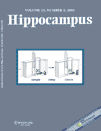Blockade of the membranal GABA transporter potentiates GABAergic responses evoked in pyramidal cells by mossy fiber activation after seizures
Abstract
The presence of a neurotransmitter within a synaptic terminal is normally due to its local synthesis. However, uptake of the neurotransmitter from the extracellular milieu by a specific membranal transporter can also explain its intraterminal accumulation. A specific vesicular transporter carries the neurotransmitter into synaptic vesicles, enabling it to be released in a calcium-dependent manner when the terminal is invaded by an action potential. Under certain circumstances, a neurotransmitter can also be released by the reversal in the direction of its membranal transporter, in a calcium-independent manner. Interestingly, γ-aminobutyric acid (GABA) can be released in this manner after epileptic activity. With intracellular recordings, in this work we show that in rats subjected to seizures, but not in naive rats, mossy fiber stimulation in the presence of glutamate receptor blockers produces bicuculline-sensitive inhibitory postsynaptic potentials (IPSPs) in pyramidal cells. The blockade of the membranal GABA transporter (GAT-1) strongly enhances the amplitude and decay time of the IPSPs in both high and low extracellular calcium concentrations. This electrophysiological evidence, together with previous neurochemical and immunohistological data, show that GAT-1 contributes to the termination of the synaptic action of mossy fiber-released GABA and rules out its involvement in depolarization-dependent GABA release. © 2005 Wiley-Liss, Inc.




